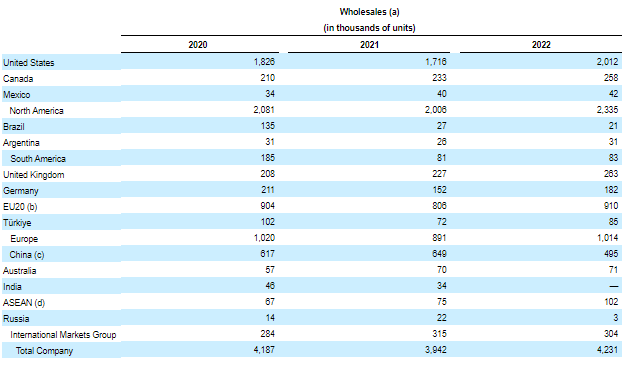The United States, China (including Taiwan) and the United Kingdom ranked as Ford Motor Company’s top markets in 2022, according to the company’s own data.
With some 173,000 employees worldwide, Ford develops and offers Ford trucks, sport utility vehicles, vans and commercial cars, and Lincoln luxury vehicles, along with connected services.
Results of Ford

The United States was its largest market, with 2 million 012,000 units sold in 2022.
Then followed, in descending order: China and Taiwan (495,000 units), United Kingdom (263,000 units), Canada (258,000 units) and Germany (182,000 units).
Ford Motor Company
The company manages its vehicle production schedule based on a number of factors, including retail sales (i.e., units sold by its dealers to their retail customers) and dealer inventory levels (i.e., the number of units its dealers have in inventory to sell to their customers).
Historically, Ford has experienced some seasonal fluctuation in the business, with production in many markets tending to be higher in the first half of the year to meet demand in the spring and summer (typically the strongest sales months of the year).
In recent years, due to the Covid-19 pandemic, semiconductor shortages and other supply constraints, production has been higher in the second half of the year.
During the past year, gross dealer inventory levels were lower than normal due largely to semiconductor shortages and other supply constraints, and the time required to fill orders for certain vehicles increased.
Raw Materials
Ford purchases a wide variety of raw materials from numerous suppliers around the world for use in the production and development of technologies in its vehicles.
These materials include base metals (e.g., steel and aluminum), precious metals (e.g., palladium), energy (e.g., natural gas) and plastics/resins (e.g., polypropylene).
With the transition to a greater mix of electric vehicles, the company expects to increase its reliance on lithium, cobalt, nickel, graphite and manganese, among other materials, for batteries.
Other major markets in 2022 included Turkey (85,000 units sold), Australia (71,000 units), Mexico (42,000 units), Argentina (31,000 units) and Brazil (21,000 units).
